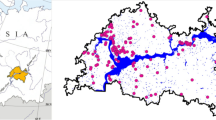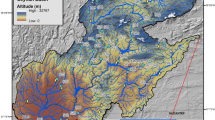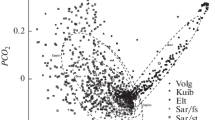Abstract
In order to assess the effects of the execution of the ‘Port of Bilbao Enlargement Project’, epifauna living on hard substrata and environmental parameters were quantitatively investigated from 1994 to 1996. A programme of repeated non-destructive sampling at 8 stations was carried out during the construction period of a breakwater and the filling operations on the shoreline. A correlation analysis was used as a method to extract potential indicator species of particular environmental conditions measured in the field. We postulate that the remaining species (about 80% of the total species data set), insensitive to any of the investigated environmental factors, were unnecessary for the purposes of assessing the environmental impact caused by the port building works. Classification and ordination techniques were then conducted at two contrasting levels by using the full species data set and the selected faunal indicator data subset. All plots showed separation of sampling sites in 3 major groups, which were easily related to the perturbations caused by a siltation gradient from the estuary mouth. This suggests that the amount of effort required in the enumeration of all the organisms sampled may be dramatically reduced by identifying only faunal indicators of environmental discontinuities in the field. So far, the engineering works developed on the western side of the bay have not caused dramatic temporal changes in species composition, or at least they have not had an effect that was larger than the variations detected among the study sites due to siltation from the estuary mouth.
Similar content being viewed by others
References
Bellan, G.: 1980, ‘Acción de los factores de polución sobre las comunidades bentónicas', in J. M. Pérès, (ed.), La Polución de las aguas marinas, Omega, Barcelona, pp. 152–171.
Bellan, G.: 1984, ‘Indicateurs et indices biologiques dans le domaine marin', Bull. Ecol. 15, 13.
Bilyard, G. R.: 1987, ‘The value of benthic infauna in marine pollution monitoring studies', Marine Pollution Bulletin 18, 581.
Cederwall, H. and Elmgren, R.: 1990, ‘Biological effects of eutrophication in the Baltic Sea, particularly the coastal zone', Ambio 19, 109.
Chintiroglou, Ch. and Koukouras, A.: 1992, ‘The feeding habits of three Mediterranean sea anemone species, Anemonia viridis (Forskål), Actinia equina (Linnaeus) and Cereus pedunculatus (Pennant)', Helgoländer Meeeresunters. 46, 53.
Christie, H. and Green, N. W.: 1982, ‘Changes in the sublittoral hard bottom benthos after a large reduction in pulp mill waste to Iddefjord, Norway, Sweden', Neth. J. Sea Res. 16, 474.
Clarke, K. R. and Green, R. H.: 1988, ‘Statistical design and analysis for a ‘biological effects’ study', Mar. Ecol. Prog. Ser. 46, 213.
Diaz, R. J.: 1992, ‘Ecosystem Assessment Using Estuarine and Marine Benthic Community Structure', in G. A. Burton (ed.), Sediment Toxicity Assessment, Lewis, Boca Raton, pp. 67–85.
Dicks, B. and Hartley, J. P.: 1982, ‘The effects of repeated small oil spillages and chronic discharges', Phil. Trans. R. Soc. Lond. B 297, 285.
Erwin, D. G.: 1983, ‘The Community Concept', in R. Earll and D. G. Erwin (eds.), Sublittoral ecology. The ecology of the shallow sublittoral benthos, Clarendon Press, Oxford, pp. 144–164.
Fauchald, K. and Jumars, P. A.: 1979, ‘The diet of worms: a study of polychaete feeding guilds', Oceanogr. Mar. Biol. Ann. Rev. 17, 193.
Ferraro, S. P. and Cole, F. A.: 1990, ‘Taxonomic level and sample size sufficient for assessing pollution impacts on the Southern California Bight macrobenthos', Mar. Ecol. Prog. Ser. 67, 251.
Ferraro, S. P. and Cole, F. A.: 1992, ‘Taxonomic level sufficient for assessing a moderate impact on macrobenthic communities in Puget Sound, Washington, U.S.A.',Can. J. Fish. Aquat. Sci. 49, 1184.
Ferraro, S. P. and Cole, F. A.: 1995, ‘Taxonomic level sufficient for assessing pollution impacts on the Southern California Bight macrobenthos-revisited', Environ. Toxicol. Chem. 14, 1031.
Field, J. G., Clarke, K. R. and Warwick, R.M.: 1982, ‘A practical strategy for analysing multispecies distribution patterns', Mar. Ecol. Prog. Ser. 8, 37.
Förstner, U. and Wittmann, G. T. W.: 1983, Metal pollution in the aquatic environment. Springer, Berlin.
Gambi, M. C., Buia, M. C., Casola, E. and Scardi, M.: 1989, ‘Estimates of Water Movement in Posidonia oceanica Beds: A First Approach', in C. F. Boudouresque, A. Meinesz, E. Fresi and V. Gravez (eds.), International Workshop on Posidonia Beds, GIS. Posidonie Publ. 2, pp. 101–112.
Gorostiaga, J. M., Saiz, J. I., Díez, I., Santolaria, A., Secilla, A. and Urkiaga, J.: 1995–7, Plan de vigilancia ambiental del Puerto de Bilbao. Final report prepared for the ‘Port of Bilbao Authority', Bilbao.
Gray, J. S., Aschan, M., Carr, M. R., Clarke, K. R., Green, R. H., Pearson, T. H., Rosenberg, R. and Warwick, R. M.: 1988, ‘Analysis of community attributes of the benthis macrofauna of Frierfjord/Langesundfjord and in a mesocosm experiment', Mar. Ecol. Prog. Ser. 46, 213.
Hartnoll, R. G.: 1983, ‘Substratum', in R. Earll and D. G. Erwin (eds.), Sublittoral Ecology. The Ecology of the Shallow Sublittoral Benthos, Clarendon Press, Oxford, pp. 97–124.
Hiscock, K.: 1983, ‘Water Movement', in R. Earll and D. G. Erwin (eds.), Sublittoral Ecology. The Ecology of the Shallow Sublittoral Benthos, Clarendon Press, Oxford, pp. 58–96.
Hiscock, K.: 1985, ‘Aspects of the Ecology of Rocky Sublittoral Areas', in P. G. Moore and R. Seed (eds.), The Ecology of Rocky Coasts, Hodder and Stoughton, London, pp. 290–328.
Kluijver, M. J. de: 1989, ‘Sublittoral hard substrate communities of the southern Delta area, SW Netherlands', Bijdr. Dier. 59, 141.
Moore, P. G.: 1972, ‘Particulate matter in the sublittoral zone of an exposed coast and its ecological significance with special reference to the fauna inhabiting kelp holdfasts', J. Exp. Mar. Biol. Ecol. 10, 59.
Muus, B. J.: 1968, ‘A field method for measuring ‘exposure’ by means of plaster balls. A preliminary account', Sarsia 34, 61.
Orive, E.: 1989, ‘Differences in phytoplankton abundance and distribution between the Abra of Bilbao and the adjacent shelf waters', Hydrobiologia 182, 121.
Pearson, T. H. and Rosenberg, R.: 1978, ‘Macrobenthic succesion in relation to organic enrichment and pollution of the marine environment', Oceanogr. Mar. Biol. Ann. Rev. 16, 229.
Pérès, J. M. and Picard, J.: 1964, ‘Nouveau manuel de bionomie benthique de la mer Méditerranée', Recl. Trav. Stn. Mar. Endoume 31(47), 1.
Petpiroon, S. and Dicks, B.: 1982, ‘Environmental effects (1969 to 1981) of a refinery effluent discharged into Littlewick Bay, Milford Haven', Field Studies 5, 623.
Rainbow, P. S.: 1984, ‘An introduction to the biology of British littoral barnacles', Field Studies 6, 1.
Reish, D. J.: 1986, ‘Benthic invertebrates as indicators of marine pollution: 35 years of study', Oceans 3, 885.
Relini, G.: 1980, Guide per il riconoscimento delle specie animali delle acque lagunari e costiere italiane. 2 Cirripedi Toracici. Consiglio Nazionale delle Ricerche, Roma.
Rogers, C. S.: 1993, ‘Responses of coral reefs and reef organisms to sedimentation', Mar. Ecol. Prog. Ser. 62, 185.
Saiz Salinas, J. I. and Isasi Urdangarín, I.: 1994, ‘Response of sublittoral hard substrate invertebrates to estuarine sedimentation in the outer harbour of Bilbao (N. Spain)', PSZNI Mar. Ecol. 15, 105.
Sneath, P. H. A. and Sokal, R. R.: 1973, Numerical taxonomy: the principles and practice of numerical classification, W. H. Freeman and Company, San Francisco.
Sokal, R. R. and Rohlf, F. J.: 1981, Biometry, 2nd ed. W. H. Freeman and Company, San Francisco.
Soule, D. F. and Kleppel, G. S.: 1988, Marine organisms as indicators. Springer, New York.
Villalba, A. and Vieitez, J. M.: 1985, ‘Estudio de la fauna de anélidos poliquetos del sustrato rocoso intermareal de una zona contaminada de la Ría de Pontevedra (Galicia). 1. Resultados biocenóticos', Cah. Biol. Mar. 26, 359.
Villate, F.: 1991, ‘Annual cycle of zooplankton community in the Abra Harbour (Bay of Biscay): abundance, composition and size spectra', J. Plankton Res. 13, 691.
Warwick, R. M.: 1988, ‘The level of taxonomic discrimination required to detect pollution effects on marine benthic communities', Mar. Poll. Bull. 19, 259.
Warwick, R. M.: 1993, ‘Environmental impact studies on marine communities: pragmatical considerations',Austr. J. Ecol. 18, 63.
Zar, J. H.: 1984, Biostatistical analysis. Prentice Hall Inc, N.J.
Rights and permissions
About this article
Cite this article
Saiz-Salinas, J.I., Urkiaga-Alberdi, J. Use of Faunal Indicators for Assessing the Impact of a Port Enlargement near Bilbao (Spain). Environ Monit Assess 56, 305–330 (1999). https://doi.org/10.1023/A:1005936627590
Issue Date:
DOI: https://doi.org/10.1023/A:1005936627590




